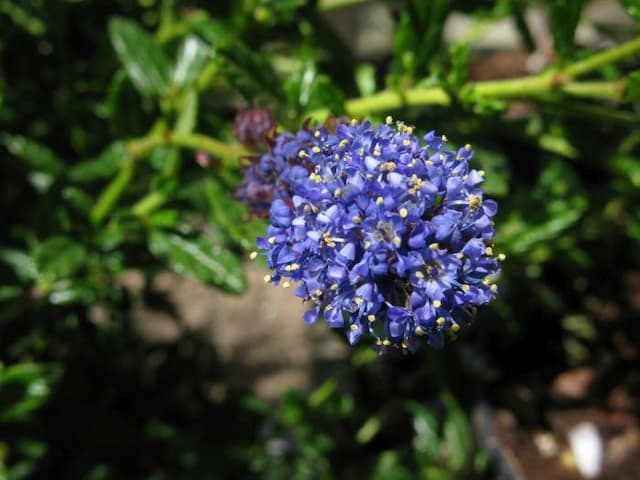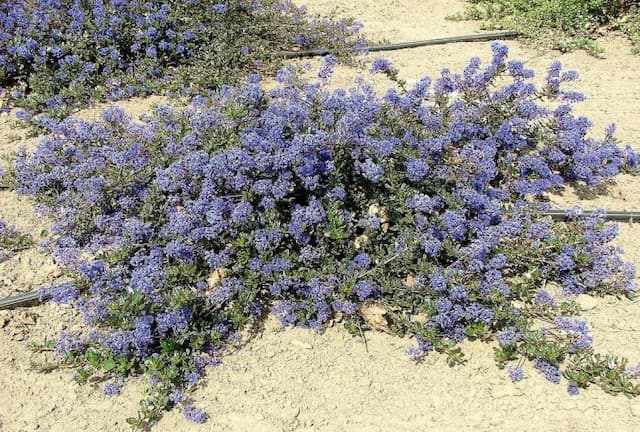Christ's thorn Paliurus spina-christi

ABOUT
A bushy shrub with slender, viciously thorny stems and rounded, glossy, bright green leaves. Clusters of small, greenish-yellow, star-shaped flowers in summer are followed by small, woody fruit, each surrounded by a large, disc-shaped wing, pale green at first, then brown, and lasting into winter
About this plant
 Names
NamesFamily
Rhamnaceae.
Synonyms
Christ's Thorn, Jerusalem Thorn, Garland Thorn, Crown of Thorns.
Common names
Paliurus aculeatus, Paliurus ramosissimus, Rhamnus paliurus, Ziziphus spina-christi.
 Characteristics
CharacteristicsLife cycle
Perennials
Foliage type
Deciduous
Color of leaves
Green
Flower color
Greenish-yellow
Height
15 feet [4.57 meters]
Spread
15 feet [4.57 meters]
Plant type
Shrub
Hardiness zones
7
Native area
Mediterranean
Benefits
 General Benefits
General Benefits- Landscape Ornamentation: Paliurus spina-christi, commonly known as Christ's Thorn, is used in ornamental landscaping for its distinctive form and branching pattern.
- Erosion Control: The deep root system of Christ's Thorn helps to stabilize soil and control erosion.
- Wildlife Habitat: The dense thicket of branches provides shelter and nesting sites for birds and other small animals.
- Food Source: The fruit of the Christ's Thorn is a source of food for various bird species, contributing to biodiversity.
- Drought Tolerance: Christ's Thorn is drought-resistant, making it suitable for xeriscaping and arid environments.
- Windbreak: The dense crown can act as a windbreak, offering protection to nearby plants and reducing wind erosion.
- Hedge Plant: The thorny branches make Christ's Thorn an effective hedge plant, creating a natural fence that deters intruders.
- Cultural and Historical Significance: The plant has a deep cultural and religious connection, especially in Christian tradition.
 Medical Properties
Medical Properties- Anti-inflammatory: Used traditionally to reduce inflammation.
- Antipyretic: Employed to reduce fever.
- Diuretic: Promotes the increase of urine production, aiding in detoxification.
- Hepatoprotective: Believed to protect the liver and aid in the treatment of liver disorders.
- Immunomodulatory: May have effects on the immune system, possibly by strengthening it.
- Antimicrobial: Shows potential in inhibiting the growth of some bacteria and fungi.
- Antioxidant: Contains compounds that may combat oxidative stress and protect cells from damage.
 Air-purifying Qualities
Air-purifying QualitiesThis plant is not specifically known for air purifying qualities.
 Other Uses
Other Uses- Fence Making: Due to its dense and thorny nature, branches of the Christ's Thorn are often used for creating living fences or barriers to keep out livestock and intruders.
- Woodworking: The wood from Christ's Thorn is hard and durable, making it suitable for crafting small wooden items such as handles and walking sticks.
- Dye Production: The fruit of the Christ's Thorn can be used to produce a yellow dye for textiles.
- Crown of Thorns: The branches are traditionally claimed to have been used to make the Crown of Thorns for Jesus Christ during the crucifixion.
- Fishing: Fishermen have used the thorns of Christ's Thorn to design improvised fishhooks.
- Decorative Art: The interweaving thorns and branches can be creatively used in decorative arts and for creating rustic ornaments.
- Symbolic Uses: The plant is used in religious and cultural symbolism, especially in Christianity, due to its association with the crucifixion.
- Soil Stabilization: The plant's extensive root system can help prevent soil erosion on slopes and embankments.
- Charcoal Production: The dense wood of the Christ's Thorn can be carbonized to produce charcoal.
- Beekeeping: Christ's Thorn is a valuable plant for beekeepers since it produces a significant amount of pollen and nectar, supporting local bee populations.
Interesting Facts
 Feng Shui
Feng ShuiThe Christ's Thorn is not used in Feng Shui practice.
 Zodiac Sign Compitability
Zodiac Sign CompitabilityThe Christ's Thorn is not used in astrology practice.
 Plant Symbolism
Plant Symbolism- Crown of thorns: Paliurus spina-christi, commonly referred to as Jerusalem Thorn or Christ's Thorn, is traditionally believed to be the plant from which the Crown of Thorns of Jesus Christ was made, symbolizing the suffering and sacrifice of Christ in Christian tradition.
- Endurance and survival: Its ability to grow in arid and poor soil conditions symbolizes resilience and the capacity to endure hardships.
- Protection: The thorns of the Jerusalem Thorn were historically used to create fences for protection, reflecting the theme of setting boundaries and safeguarding what is valuable.
- Redemption: In Christian symbolism, the plant is sometimes associated with the concept of redemption, as it's linked with the Passion of Christ and the hope of resurrection and salvation.
 Water
WaterFor the Jerusalem Thorn (Paliurus spina-christi), watering should be conducted moderately. It is best to water the plant when the top inch of soil feels dry, which could roughly be once every week or two, depending on the climate and the plant's environment. Offer the plant about 1-2 gallons of water per watering session to ensure even soil moisture but avoid waterlogging. In hot, dry periods, increase the frequency to once a week, and during winter, reduce watering to once every few weeks as the plant requires less moisture during dormancy.
 Light
LightThe Jerusalem Thorn thrives in full sun conditions. It should be placed in a location where it receives at least six to eight hours of direct sunlight daily. The ideal spot would be an unobstructed south-facing location outdoors where it can bask in the sun's rays, which is essential for its flowering and overall growth.
 Temperature
TemperatureThe Jerusalem Thorn prefers a warm climate and grows best in temperatures ranging from 50 to 80 degrees Fahrenheit. It can withstand short periods of colder weather down to around 10 degrees Fahrenheit, but it is best to protect it from prolonged freezes. Ideally, maintain a temperature above 50 degrees Fahrenheit for optimal growth conditions.
 Pruning
PruningThe Jerusalem Thorn requires pruning to maintain shape, remove dead or damaged branches, and promote healthy growth. Pruning is best done in late winter or early spring before new growth starts. Cut back any overly long branches, thin out dense areas, and remove any crossing or rubbing branches. Aim for an open, well-ventilated canopy structure to enhance the plant's health and appearance.
 Cleaning
CleaningAs needed
 Soil
SoilJerusalem Thorn thrives in well-draining, loamy soil with a pH range of 6.0 to 7.5. A mix of two parts loam, one part sand, and one part compost or peat will create an ideal growing medium for this plant.
 Repotting
RepottingJerusalem Thorn doesn't require frequent repotting; it can be done every 2-3 years as the plant outgrows its container or the soil becomes depleted.
 Humidity & Misting
Humidity & MistingJerusalem Thorn is relatively tolerant of varying humidity levels but prefers a moderate to dry atmospheric condition, similar to its native Mediterranean habitat.
 Suitable locations
Suitable locationsIndoor
Place in bright, indirect light; water sparingly.
Outdoor
Full sun, well-drained soil, protect from harsh winds.
Hardiness zone
7-11 USDA.
 Life cycle
Life cyclePaliurus spina-christi, commonly known as Christ's thorn, begins its life cycle when seeds germinate after a period of cold stratification, usually after winter passes. The seedling stage is characterized by the emergence of the first pair of true leaves, after which the plant enters the vegetative stage, growing its characteristic spiny branches, compound leaves, and robust stem. As the plant matures, it reaches the flowering stage, producing yellowish-green flowers arranged in umbrella-like clusters that attract pollinators. Following pollination, the plant develops its unique fruit, a hard, flat capsule surrounded by a wing-like structure that aids in seed dispersal. The fruit matures and eventually drops to the ground, where the seeds may lie dormant until conditions are right for germination. Over the years, Paliurus spina-christi may grow into a sizeable, thorny shrub or small tree that continues this life cycle, living for several decades and withstanding drought and poor soil conditions.
 Propogation
PropogationPropogation time
Spring-early summer
Paliurus spina-christi, commonly known as Christ's Thorn, is typically propagated from seed. The most popular method involves collecting the seeds after the fruit has ripened, which usually occurs in autumn. To begin, the seeds require a period of cold stratification to break dormancy; this can be achieved by mixing the seeds with moist sand and storing them in the refrigerator at a temperature between 35 and 40 degrees Fahrenheit (about 2 to 4 degrees Celsius) for approximately two to three months. Following the stratification period, the seeds can be sown in well-draining soil and should be planted at a depth of about a half-inch (approximately 1.3 centimeters). Germination can be sporadic, so patience is key, and once seedlings have emerged and grown strong enough, they can be transplanted outdoors in a sunny location with well-drained soil.









